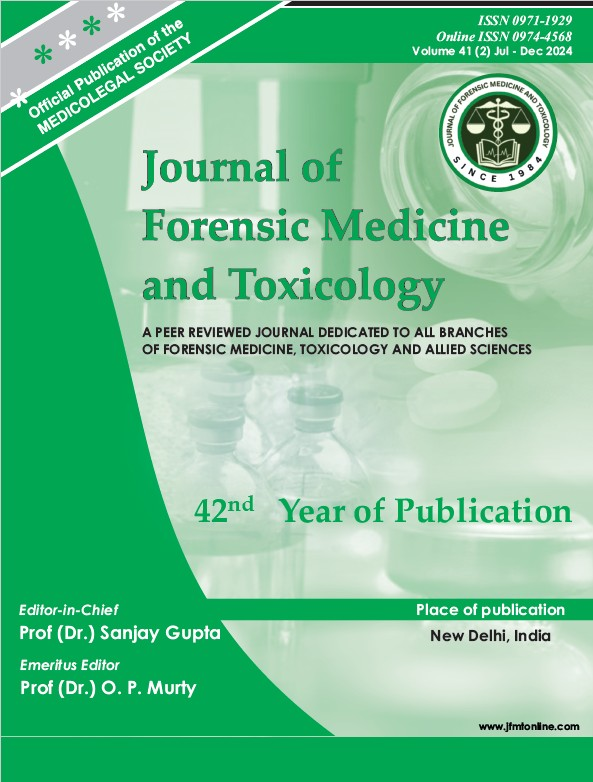VIRTUAL AUTOPSY’S IMPACT ON DIAGNOSING BRAIN- RELATED DEATHS IN FORENSIC MEDICINE: A SYSTEMATIC REVIEW
Keywords:
Advanced imaging techniques, Brain-related deaths, Computed tomography, Diagnosing, Forensic neuropathology, Virtual autopsyAbstract
Introduction: Due to the complexity of the brain’s components, traditional autopsies frequently have difficulty detecting brain injuries. The development of virtual autopsies, which make use of cutting-edge imaging technology, presents an opportunity for forensic medicine. This abstract examines the use of virtual autopsy in forensic neuropathology and how it affects the identification of fatal brain injuries. Virtual autopsies have the potential to increase the precision and efficacy applying cutting-edge imaging techniques. Aim: This study aims to investigate the efficacy of virtual autopsy in diagnosing brain-related deaths. Methodology: This article focused on virtual autopsies in diagnosing brain-related deaths. Various sources were searched for relevant information, analyzing the methodology, advantages, and limitations. It resulted in 114 hits, with 60 articles initially selected. After analysis, the sample was reduced to 54, excluding 21 samples due to download issues. Quality concerns led to the elimination of 33 articles, leaving 7 for full-text analysis. Finally, 26 papers were chosen for the study (n=26). Result: Without intrusive procedures, virtual autopsy helps in identifying minor anomalies such as hemorrhages, wounds, malignancies, and infarctions. The non-invasive strategy improves diagnosis accuracy by lowering risks and making data storage, retrieval, and communication among professionals easier. Conclusion: Virtual autopsy in forensic medicine is increasingly utilized to identify brain-related fatalities. Precise brain imaging helps locate and assess complex abnormalities, aiding accurate diagnosis and potential advancements in forensic neuropathology. More research and technological development are necessary to enhance its diagnostic capabilities and transform forensic medicine.
Downloads
References
Case ME, Graham MA, Handy TC, Jentzen JM, Monteleone JA, National Association of Medical Examiners Ad Hoc Committee on Shaken Baby Syndrome. Position paper on fatal abusive head injuries in infants and young children. The American Journal of forensic medicine and Pathology. 2001 Jun 1;22(2):112-22.
Smith SM, Fox PT, Miller KL, Glahn DC, Fox PM, Mackay CE, Filippini N, Watkins KE, Toro R, Laird AR, Beckmann CF. Correspondence of the brain’s functional architecture during activation and rest. Proceedings of the national academy of Sciences. 2009 Aug 4;106(31):13040-5.
Wichmann D, Obbelode F, Vogel H, Hoepker WW, Nierhaus A, Braune S, Sauter G, Pueschel K, Kluge S. Virtual autopsy as an alternative to traditional medical autopsy in the intensive care unit: a prospective cohort study. Annals of internal medicine. 2012 Jan 17;156(2):123-30.
Azcona EA. Geometric Deep Learning in Neuroimaging and Human Reward Behavior (Doctoral dissertation, Northwestern University).
Barbone GE, Bravin A, Mittone A, Grosu S, Ricke J, Cavaletti G, Djonov V, Coan P. High-spatial-resolution three-dimensional imaging of human spinal cord and column anatomy with postmortem X-ray phase contrast micro-CT. Radiology. 2021 Jan;298(1):135-46.
Langfitt TW, Obrist WD, Alavi A, Grossman RI, Zimmerman R, Jaggi J, Uzzell B, Reivich M, Patton DR. Computerized tomography, magnetic resonance imaging, and positron emission tomography in the study of brain trauma: preliminary observations. Journal of neurosurgery. 1986 May 1;64(5):760-7.
Lakhan SE. Schizophrenia proteomics: biomarkers on the path to laboratory medicine? Diagnostic Pathology. 2006 Dec;1:1-3.
Deshmukh KP, Rahmani Dabbagh S, Jiang N, Tasoglu S, Yetisen AK. Recent technological developments in the diagnosis and treatment of cerebral edema. Advanced NanoBiomed Research. 2021 Nov;1(11):2100001.
Sohlberg MM, Mateer CA, editors. Cognitive rehabilitation: An integrative neuropsychological
approach. Guilford Press; 2001 May 25.
Khimchenko A, Deyhle H, Schulz G, Schweighauser G, Hench J, Chicherova N, Bikis C, Hieber SE, Müller B. Extending two-dimensional histology into the third dimension through conventional micro-computed tomography. NeuroImage. 2016 Oct 1;139:26-36.
O’Donnell C, Woodford N. Post-mortem radiology— a new sub-specialty?. Clinical radiology. 2008 Nov 1;63(11):1189-94.
Emery DC, Shoemark DK, Batstone TE, Waterfall CM, Coghill JA, Cerajewska TL, Davies M, West NX, Allen SJ. 16S rRNA next-generation sequencing analysis shows bacteria in Alzheimer’s post-mortem brain. Frontiers in aging neuroscience. 2017:195.
Burton JL, Underwood J. Clinical, educational, and epidemiological value of autopsy. The Lancet. 2007 Apr 28;369(9571):1471-80.
Barrett D, Kipper G. Virtualization and forensics: A digital forensic investigator’s guide to virtual environments. Syngress; 2010 Aug 6.
Gunn A. Essential forensic biology. John Wiley & Sons; 2019 Mar 18.
Akram W, Kumar R. A study on positive and negative effects of social media on society. International Journal of Computer Sciences and Engineering. 2017 Oct 30;5(10):351-4.
Campos C, Rocha NB, Lattari E, Paes F, Nardi AE, Machado S. Exercise-induced neuroprotective effects on neurodegenerative diseases: the key role of trophic factors. Expert review of neurotherapeutics. 2016 Jun 2;16(6):723-34.
Behrman RE, Field MJ, editors. When children die: Improving palliative and end-of-life care for children and their families.
Hassell LA, Absar SF, Chauhan C, Dintzis S, Farver CF, Fathima S, Glassy EF, Goldstein JA, Gullapalli R, Ho J, Koch LK. Pathology education powered by virtual and Digital transformation: Now and the future. Archives of Pathology & Laboratory Medicine. 2023 Apr;147(4):474-91.
Natali F, Dolce C, Peters J, Gerelli Y, Stelletta C, Leduc G. Water dynamics in neural tissue. Journal of the Physical Society of Japan. 2013 Jan 1;82(Suppl. A):SA017.
Filograna L, Pugliese L, Muto M, Tatulli D, Guglielmi G, Thali MJ, Floris R. A practical guide to virtual autopsy: why, when and how. InSeminars in Ultrasound, CT, and MRI 2019 Feb 1 (Vol. 40, No. 1, pp. 56-66). WB Saunders.
Zhang M. Forensic imaging: a powerful tool in modern forensic investigation. Forensic Sciences Research. 2022 Sep;7(3):385-92.
Thali MJ, Dirnhofer R, Vock P, editors. The virtopsy approach: 3D optical and radiological scanning and reconstruction in forensic medicine. CRC Press; 2009 May 14.
Jacobsen C, Bech BH, Lynnerup N. A comparative study of cranial, blunt trauma fractures as seen at medicolegal autopsy and by computed tomography. BMC medical imaging. 2009 Dec;9(1):1-9.
Baglivo M, Winklhofer S, Hatch GM, Ampanozi G, Thali MJ, Ruder TD. The rise of forensic and post mortem radiology—analysis of the literature between the years 2000 and 2011. Journal of Forensic Radiology and Imaging. 2013 Jan 1;1(1):3-9.
Schultheis MT, Himelstein J, Rizzo AA. Virtual reality and neuropsychology: upgrading the current tools. The Journal of head trauma rehabilitation. 2002 Oct 1;17(5):378-94.




